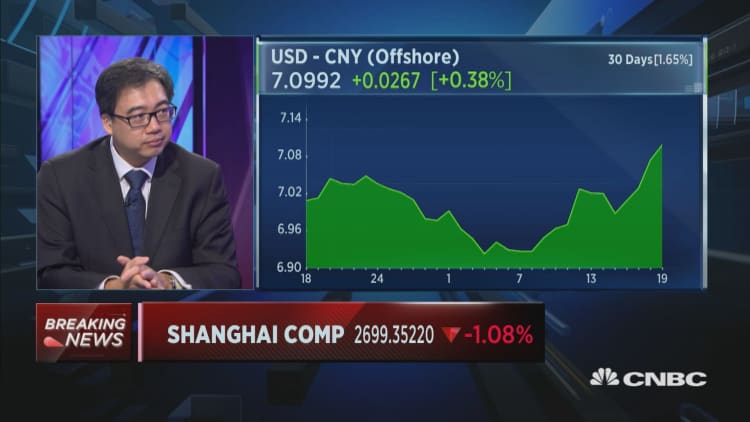
World markets are facing a simple but serious problem: There just aren't enough dollars to execute trades and transactions.
That explains why the trade-weighted dollar index, gained more than 4% last week. The broad dollar index measures the value of the dollar against a basket of currencies, namely the euro, pound, yen, Canadian dollar, Swiss franc and Swedish krona.
Given the scarcity of dollars, the U.S. Federal Reserve last week announced that it set up financing channels with nine other central banks, including the Reserve Bank of Australia and Monetary Authority of Singapore, to stabilize currency markets.
We will need to see the COVID-19 new infection numbers peak and start to trend lower before we see a bottom to the risk selloff and a turn in the dollar strength.Khoon Gohhead of Asia research, ANZ Bank
That opened access to $450 billion of additional dollar funds, with a commitment to keep the arrangement in place for at least six months.
However, analysts aren't sure if that amount will be enough to contain the fear among investors who are hoarding dollars as market gains evaporate.
Khoon Goh, head of research at Melbourne-based ANZ Bank, thinks the greenback will rise to 105 on the dollar index in the short term. As of Tuesday it stands near 102, and last was at 105 in late 2002.
"The swap lines will help to some extent. However, it is unlikely to be sufficient given the extent of dollar demand. From a technical perspective, the dollar looks overbought, so some consolidation can be expected. However, this is likely just a pause before another push higher," Goh told CNBC in an email.
The Fed announced open-ended additional stimulus on Monday, and Goh acknowledged that some steam came off the dollar rally.
"We will probably see the greenback consolidate for a while, but the key will be how other major central banks respond as well," he said. "If the (European Central Bank) and (Bank of Japan) also start to announce more measures of their own, that could still push the dollar index toward 105 over the short term."
The dollar spike isn't surprising given extreme market volatility and investor fears that go along with it. But a number of aspects to the rise are worrying some analysts:
- Bad news for emerging market assets – With many currencies like the Brazilian real, Indian rupee and Indonesian rupiah plunging to record lows, the next move to watch for is a G20 level currency intervention. With the Fed funds rate in the U.S. down to near zero and most emerging market central banks cutting rates aggressively, the yield advantage for those countries' currencies has withered away.
- Negative for US exports – At a time when President Donald Trump has repeatedly said he doesn't like a strong dollar, the rally will be detrimental for U.S. exports, especially once the pandemic curve flattens and consumer and industrial demand bounce back.
- Top reserve currency of the world – According to the IMF, more than 61% of all foreign bank reserves are in U.S. dollars. Plus, nearly 40% of the world's debt is in dollars. Together with the euro, the two currencies dominate 80% of global reserves. The Chinese renminbi, despite the country being an integral part of global trade, makes up less than 2% of global currency reserves. That creates over-dependence on the U.S. greenback.
- Euro-dollar parity – Foreign exchange markets are watching this currency pair closely. Divya Devesh, forex analyst at Standard Chartered, said he sees diverging economic performance between the United States and Europe. "We project full-year 2020 GDP growth of -3.0% in the euro-area versus -0.3% in the U.S.," he said in an email. "Expected economic underperformance is likely to weigh on the euro."
Any solution to the dollar frenzy is linked to an eventual easing of the coronavirus infection rate, said Goh.
"We will need to see the COVID-19 new infection numbers peak and start to trend lower before we see a bottom to the risk selloff and a turn in the dollar strength," he said.
However, Divya Devesh, of Standard Chartered, said the moves by the Fed could be a silver lining to unabated dollar demand. The objective of those daily operations is to convince market participants that sufficient dollars will be readily available. That in turn should support financial institutions in lending to each other more confidently. "It is all about signaling," Devesh said.
The number one risk for world markets associated with dollar shortfall, is a potential rise in defaults.
Traders are watching the spread between two bank lending rates, the London Interbank Offered Rate (LIBOR) and the Overnight Indexed Swap (OIS). Since 2008, that spread has been seen as a warning sign of credit risk within the banking industry.
"The key issue facing policy makers is to ensure that the economic challenge doesn't lead to an insolvency event," Divya says.
He believes that the policy response, globally, has so far been strong and is likely to get more aggressive in the coming weeks.
"In the meanwhile," he said, "the markets will remain on high alert given the risks of an unintended spill over to credit markets."


